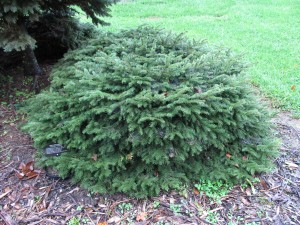Bird’s nest spruce (Picea abies ‘Nidiformis’) is a dwarf cultivar of Norway spruce and is native to northern Europe (USDA hardiness zones 3-7). This slow growing compact shrub will attain 4 feet in height and 5 to 6 feet spread over 15 – 20 years.
The shrub grows in a round form with a distinctive flat depression or “bird’s nest” cavity on top. Lush, dark green needle foliage has a medium to fine texture and deer stay away from this sharp needle conifer. Short ½ inch long needles radiate along the slightly uplifted branches.
Bird’s nest spruce grows in average acidic, well-drained soil; it is best planted in full sun to partial shade with good air circulation. In the mid-south, this shrub conifer tends to struggle during periods of extreme heat and drought. Best specimens are seen in gardens from northern Virginia and northward and through the Midwest U.S. where summers tend to be less humid and a bit cooler.
When needles appear pale or off color, feeding spruce and eriophyid mites may be the problems. Pesticide controls are very effective; also hosing down the shrub with a coarse spray of water will wash away most mites. This naturally dwarf plant rarely requires pruning, other than to remove any damaged, discolored and/or diseased twigs.
Bird’s nest spruce has year-round appeal. It is frequently included in foundation or low border plantings. It is exceptionally winter hardy and may be planted in a large container.
Extra: Picea abies ‘Maxwell’ exhibits a similar form except its top is flat but not depressed.


 Posted in
Posted in 
